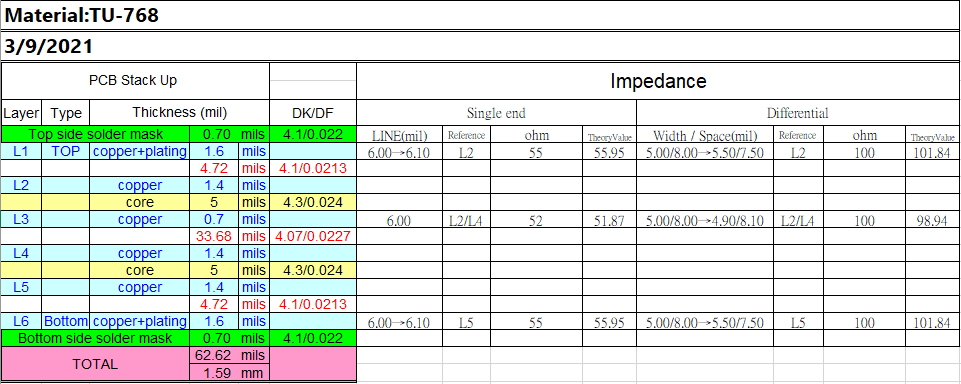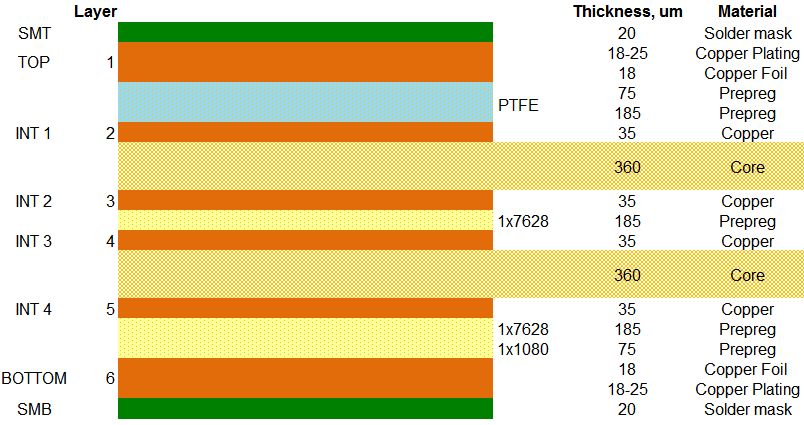Selecting Alternative PCB Substrate Materials for Multilayer Boards

Sometimes, it pays to go against the grain. FR4 substrates are by far the most popular option you'll find from fabricators, and each fabricator has their preferred supplier. However, you might want to pursue alternative PCB substrate materials for a multilayer board. Although there are multiple PCB laminate material manufacturers, the broad class of available substrates is somewhat limited.
If you need to build a device that is specialized for extreme environments, repeated thermal cycling, or high speed/RF devices, there are alternative materials for multilayer PCB substrates that may be a better choice. I'll show some examples in this article, although I'll do my best to be vendor-agnostic. What's more important is to understand the criteria for selecting an alternative to an FR4 substrate, and I'll provide the criteria that are important for various applications.
You Don’t Have to Settle For an FR4 Substrate
What we call "FR4" is actually a National Electrical Manufacturers Association (NEMA) designation for a class of materials; it is not one specific material or even one specific material composition. These PCB laminates comply with the UL94V-0 standard on inflammability of plastic materials.
Drawbacks of FR4
While FR4 is by far the most popular substrate material for single and multilayer PCBs, it has its drawbacks:
- Low thermal conductivity: Like other electrical insulators, FR4 is also a poor thermal conductor compared to other materials that are suitable for supporting printed circuits.
- Moderately lossy: FR4 substrate laminates is known for its lossy characteristic, given by its loss tangent of ~0.02 at about 1 GHz. Routing striplines or a substrate integrated waveguide will ensure high isolation from other signals, but at the expense of greater attenuation as the signal sees the entire loss tangent.
- Fiber weave effects: At several 10's of GHz, the glass weave used in FR4 laminates creates interesting effects like accumulated skew and resonant losses along the signal propagation path.
- Mismatch with copper CTE: The z-axis coefficient of thermal expansion (CTE) value of most FR4 laminates has a large mismatch with copper (typically FR4:Cu = ~3:1). This is only a major problem under repeated thermal cycling or extreme temperature excursions above the glass transition temperature.
For simple designs that run at low speed/low frequency, and that won't be running too hot or in an extreme environment, these drawbacks probably won't matter. For more modern designs, it's important to at least consider alternatives to FR4. Before you start designing around an alternate PCB substrate material, talk to some fabricators to see what materials they can work with in their process, and to see what layer thicknesses they recommend in their stackups. They'll send you back a PCB stackup table like that shown in the image below.

Thermal Demands and Reliability
Given the thermal demands in modern PCBs that operate at high speed and/or high frequency, and given the harsh environments in which these systems are being deployed, it might make sense to use a different material for your next PCB. You've got a few options for substrate materials, or some alternative design choices to try and deal with high heat in some applications.
Using a board with higher thermal conductivity allows heat to easily spread throughout the board, allowing your board to operate at a more uniform temperature. FR4 boards with high speed/high frequency devices can develop hot spots around the larger high speed processors (e.g., FPGAs or MPUs). The overall thermal conductivity of the board can be increased by using some alternative material or using additional plane layers. In these boards, you should be using heat sinks on important components anyways, or possibly a fan for some airflow. Another option is to use a thermal interface material to bond the board to its enclosure, giving a path for heat directly back to the enclosure.
Alternative Multilayer PCB Substrate Material Examples
In this section, I want to present some alternative options that some designers may not have considered. These alternative materials target a specific drawback seen in FR4 substrates. It's important to note that there is no single alternative PCB substrate material that overcomes every drawback of FR4 laminates. Instead, you need to pick the specific drawback that matters for your system. Some examples are found in the following table:
|
|
|
|
|
|
|
|
|
|
|
|
|
|
|
|
|
|
|
|
|
|
|
|
Metal-core or Metal-backed Boards
Thermal management in FR4 boards can be complemented by using a metal core or metal-backed board. The large slab of aluminum used in these boards nicely allows heat to be dissipated throughout the board and into an enclosure or housing, ensuring a more even temperature distribution. This is useful in a number of applications, such as boards for LED lighting or high power regulators in unique environments.
Ceramics
Alternative materials for multilayer PCB substrates provide other advantages besides thermal management. As an example, the manufacturing process for ceramic PCBs allows passive components to be embedded in the inner layers of a multilayer ceramic PCB. The mixture of materials required to create a ceramic board allows their mechanical properties to be tuned while maintaining a high ratio of thermal to electrical conductivity. The thermal expansion coefficient of ceramics for PCBs is closer to that of most conductors, which reduces mechanical stress during cycling.
Composite Epoxy Material (CEM)
One popular alternative group of materials, especially in Asia, is composite epoxy materials (CEM), specifically CEM-3. This class of composite materials is made from woven glass fabric surfaces and a non-woven glass core combined with an epoxy synthetic resin. Some manufacturers advocate that CEM-3 should completely replace FR4 as it is cheaper to produce, provides the same level of flame retardance, and is usable with the same manufacturing processes as FR4.
The glass transition temperature of CEM-3 (approximately 125 °C) is similar to that of FR4 (approximately 135 °C). Other CEM-based materials, for example CEM-1 and CEM-2, have much lower glass transition temperatures and should not be used with multilayer boards. Most manufacturers will only recommend using CEM-3 for low layer counts, although it is being used to replace FR4 boards with a similar number of layer counts.
High Frequency Laminates
A PCB laminate material that is classified as "high frequency" could refer to its usefulness in two important areas:
- Low loss tangent at high frequencies, normally ~0.003 or less at ~10 GHz or higher
- Fiber weave effects, although these laminates may have the same loss tangent as typical FR4 materials
Materials that satisfy both criteria are often used in applications like radar modules operating at 24 GHz (short range), 76-77 GHz (long range), or 77-81 GHz (short range). Other specialty applications are imaging radar, drone radar, wireless MANs, remote sensing, SATCOM, remote sensing, and much more. In the digital realm, alternative PCB substrate materials for high frequencies are needed to allow for very long channel lengths, such as in backplanes or server motherboards. For example, large 3U/6U backplanes can have high-speed channel lengths reaching 20 inches with bandwidths reaching beyond radar frequencies. If we designed this board on FR4, you'd never recover the signal from a channel that long.
Probably the two most popular high frequency PCB substrate materials are PTFE-based laminates (Teflon) with microglass filler (e.g., Rogers) and Megtron. In devices that will operate at high frequency, using one of these high frequency PCB laminate materials may be the best choice if your routing channels will be very long. In short channels, return loss will be the dominant loss mechanism
Hybrid Construction with PTFE
High speed/high frequency laminates are often used in the outer layer of high speed/high frequency PCBs in order to reduce signal attenuation. PTFE-based laminates are normally placed on top of an inner core in high speed devices, naturally allowing it to be used with multilayer PCBs. Compared to FR4, Teflon is recommended for GHz and higher frequencies and data transfer rates due to its much lower dispersion and lower dielectric constant, leading to a faster signal propagation speed at these high speeds.
PTFE provides other advantages as well. It is a poor absorber of water, so it is useful in humid or wet environments. It can be used as a surface-layer or interior laminate layer with a number of materials, thus it can be used to form a low loss layer specifically for high speed/high frequency signals. However, it is more expensive than FR4 and is more challenging to work with in stackup construction as it requires pressing at ~370 °C. It also has lower thermal conductivity than FR4, so thermal management in PTFE boards is important.

PCB Laminate Materials of the Future
There are a variety of other materials that can be used for high speed, high temperature, and HDI multilayer boards. There are several materials companies that are working on the next generation of alternative high frequency PCB laminates and bondplies. Once these newer materials are hit the market, you can start working with them in your layout and stackup if you're using the right PCB design software.
No matter which alternative materials for PCB substrate material you use in your next multilayer board, you need the right design software to create your PCB stackup and your physical layout. Altium Designer® was created with the tools that allow you to build advanced PCBs for any application. The stackup materials compiles relevant electrical and mechanical specifications for a broad range of materials, and this tool interfaces directly with your design, simulation, and documentation features in a unified design environment.
Download a free trial of Altium today to learn more about the board design features and the design environment. You’ll also have access to the industry’s best design features in a single program. Talk to an Altium expert today to learn more.
